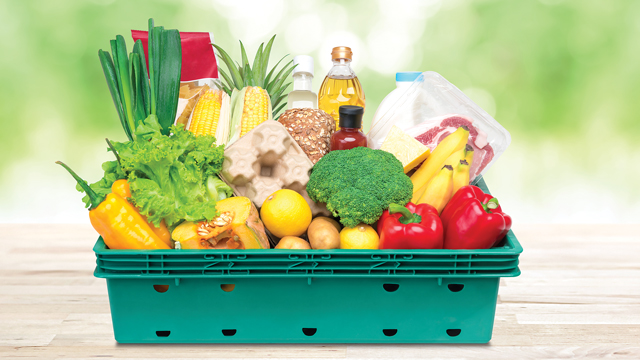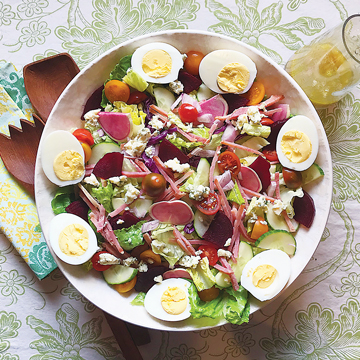Few things have come more sharply into focus for the family than cooking and eating during these last months spent at home. Food comforts us, brings us together, and reminds us of our primal needs. As parents, we have to source food, cook it, and clean up after we eat it. Repeat. Repeat. Repeat.
As a chef and a parent, somedays I find myself totally burnt out by dinner time. I have to remember my commitment to nourishing my growing kids and husband, whose work is essential. To get in the mood, I pop open a soda water, turn on some tunes, and fire up the stove. I also enlist my family to get the table ready and empty the dishwasher while I cook. It’s not always Instagram-worthy, and sometimes, it’s downright simple, but we got this RFM fam, we got this!
A few notes on shopping:
Grocery shopping has changed drastically and many companies have had to adapt. There are now restaurant supply companies that will do residential sales, and they have competitive prices on produce. You order, they pack it, and you pick it up. There are a few online farmer’s markets that let you pre-order and pick up, and other local farmer’s markets have begun to establish consistent hours for safe, outdoor shopping (check the RFM calendar).
Grocery delivery is popular, but poses many challenges with vanishing delivery windows and out-of-stock items. Pre-ordering online and curbside pickup are also available at some local grocery stores. If you’re venturing to the grocery store to do your shopping, you’ll encounter arrows in the aisles and limits on some of the items you want to buy. The stress over shopping is real, very real.
When you’re making a list, it’s helpful to plan weekly menus or at least have a good idea of what you know your family will eat. Try creating a list of twenty dinners your family loves that you like to cook. This is a great time to think in terms of themed cooking nights – taco Tuesday, pasta party, a soup bar, or burger night. Take an inventory of what you have in the pantry, fridge, and freezer. Before going shopping, make sure you have a list and make it flexible. No garlic you say? Grab a bag of pre-peeled or a jar of minced garlic. Garlic powder might do the trick instead.
If the store you went to is low on protein, check the freezer section and grab some frozen shrimp and meatballs. Stay flexible and ask for help from an employee if you’re unsure and need certain things. Whatever you do, please don’t hoard; this leads to shortages and more hoarding. Try to get what you need for two weeks. The stores will still be there and they will be restocked. Have extra food? Offer to a food pantry or a neighbor who may not be able to get out as often.
A few notes on eating:
While we are under more stress than usual, we are more prone to emotional eating. Be aware when you find yourself looking for a snack. Keep healthy snacks on hand and within reach for kids, such as fresh fruits, nuts, cheese sticks, low-sugar yogurts, hard-boiled eggs, or popcorn.
For emotional health, try to maintain a family meal schedule; this can help everyone discuss and process their day. It’s also important to find a few moments to express gratitude for what you have and consider discussing the hardships others are facing. Our kids are under a lot of stress these days as well, so take the time to reflect and help them come to terms with these unusual times. Be kind to yourself when you feel overwhelmed. One of the best nights we had was when I just couldn’t bring myself to cook and we ordered pizzas and ate in the backyard around a fire.
Final notes on cooking:
I do this for a living, and trust me, it can be very stressful. Here are a few strategies to keep you going:
1. Plan dinner early in the day to allow time for meats to thaw. If you find yourself with a few minutes in the afternoon, you might be able to knock out the prep for dinner. Chop the vegetables for a salad or gather your canned items for the recipe you chose. Trust me, deciding on dinner is half the battle and a big stress reliever.
2. Make leftover night a thing. Take out all the leftovers from the last few days and reheat. You can get creative and serve leftover meats or veggies as tacos or fried rice.
3. Try batch cooking. Make more than you will eat in one night and freeze the whole thing for another meal.
4. Enlist help! Many hands make light work. Rotate the nights of cooking to keep the peace. Teach your kids to cook and eat what they prepare.
5. Don’t stress over missing ingredients. If you don’t have something you need, work around it or look up a substitution.
6. Plan for burnout. There will be nights when you just can’t swing a scratch meal. Stock up on healthy freezer-friendly options.
7. Give yourself a break. If you just can’t do it another night, support a neighborhood restaurant that has a reliable take-out system.
Quarantine Chef Salad
Chef salads are great for a flexible weeknight dinner. When chopping vegetables for this salad, keep them bite-sized, but not too small. Make sure to wash and peel any vegetables that need it. Here is a list of possible ingredients:
Lettuce: Romaine, red leaf, mixed greens, Boston bibb, arugula, spinach
Veggies: steamed beets, cucumbers, tomatoes, radish, carrots, cabbage, avocado, onion
Protein: sliced ham, chicken, turkey, hard-boiled eggs, beans, bacon crumbles
Cheese: blue cheese, cheddar, Swiss, feta
Extras: croutons, quinoa, farro, nuts, pickled veggies, roasted veggies
Dressing
1/4 cup white wine vinegar
2 teaspoons dijon mustard
2 teaspoons maple syrup or other sweetener
½ small shallot, diced small
½ teaspoon salt
½ teaspoon freshly ground black pepper
3/4 cup olive oil
Whisk together in a small bowl: vinegar, mustard, maple syrup, shallots, salt, and pepper. Slowly pour in olive oil a few drops at a time until the mixture comes together and emulsifies.
Assembly
In a large serving bowl or salad bowl, layer in salad greens with any cabbage or other greens. Add chopped veggies either in rows or all over the top. Add any proteins and extras you choose, then dot with cheese. Just before serving, pour over the dressing and lightly toss. When serving, take care to make sure each plate gets a little bit of everything.
Photo: Jenny Tremblay West





